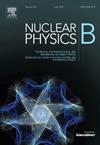Cosmology of quasi-dilaton massive gravity with non-minimal kinetic coupling
IF 2.8
3区 物理与天体物理
Q2 PHYSICS, PARTICLES & FIELDS
引用次数: 0
Abstract
In this study, we introduce an extension of the quasi-dilaton massive gravity theory and derive the field equations by varying the action with respect to the metric. This extension elucidates the dynamics of the system and demonstrates how it can encompass and recover previous cosmological models through different parameter values. We present the cosmological background equations to analyze self-accelerating solutions that can explain the late-time accelerated expansion of the Universe, driven by an effective cosmological constant arising from massive gravity. Besides, we apply the quasi-dilaton massive gravity theory with non-minimal kinetic coupling to a Type Ia Supernovae (SNIa) data set to test its viability. Our findings indicate that the theory is able to account for the observed acceleration of the expansion of the universe without invoking dark energy. In addition, we carry out a comprehensive perturbation analysis examining tensor, vector, and scalar perturbations independently. We derive the dispersion relation of gravitational waves in a Friedman-Lemaitre-Robertson-Walker (FLRW) cosmology and determine the stability conditions of the system. Such an analysis results in a sharper quasi-dilaton massive gravity theory with non-minimal kinetic coupling by ensuring the stability conditions of the system are maintained and that strong constraints on theory parameters are provided.
具有非极小动力学耦合的准膨胀大质量引力宇宙学
在这项研究中,我们引入了准膨胀质量引力理论的一个扩展,并通过改变作用相对于度规推导了场方程。这个扩展阐明了系统的动力学,并演示了它如何通过不同的参数值包含和恢复以前的宇宙学模型。我们提出了宇宙学背景方程来分析自加速解,这些解可以解释由大质量引力产生的有效宇宙学常数驱动的宇宙晚时间加速膨胀。此外,我们将具有非极小动力学耦合的准膨胀大质量引力理论应用于一个Ia型超新星(SNIa)数据集来验证其可行性。我们的发现表明,该理论能够解释观测到的宇宙加速膨胀,而不需要调用暗能量。此外,我们进行了一个全面的微扰分析,检查张量,矢量和标量微扰独立。导出了FLRW宇宙论中引力波的色散关系,并确定了系统的稳定性条件。这种分析通过保证系统的稳定性条件和对理论参数的强约束,得到了具有非极小动力学耦合的更锐利的准膨胀质量引力理论。
本文章由计算机程序翻译,如有差异,请以英文原文为准。
求助全文
约1分钟内获得全文
求助全文
来源期刊

Nuclear Physics B
物理-物理:粒子与场物理
CiteScore
5.50
自引率
7.10%
发文量
302
审稿时长
1 months
期刊介绍:
Nuclear Physics B focuses on the domain of high energy physics, quantum field theory, statistical systems, and mathematical physics, and includes four main sections: high energy physics - phenomenology, high energy physics - theory, high energy physics - experiment, and quantum field theory, statistical systems, and mathematical physics. The emphasis is on original research papers (Frontiers Articles or Full Length Articles), but Review Articles are also welcome.
 求助内容:
求助内容: 应助结果提醒方式:
应助结果提醒方式:


